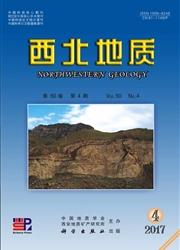

 中文摘要:
中文摘要:
通过对山西石炭系本溪组铝土矿,即华北G层铝土矿形成的构造背景、古地理环境及铝土矿床的分布分析,指出了山西铝土矿矿床主要分布在各古陆、古岛边缘的成矿盆地中,且成矿盆地的封闭性越好越有利于成矿。古陆上广泛出露的铝硅酸盐岩经过风化分解,其中的K、Na、Ca、Mg等元素大多数被淋失,Fe、Al、Ti、Si等元素相对富集,残留在红土风化壳中,经海侵短距离机械搬运至沉积盆地沉积。通过对铝土矿成分及其围岩物质组分的分析,进一步确认沉积在古陆边缘的原始铝土矿层埋藏于潜水面以下的还原环境中,经地下水、地表水等酸性溶液的淋滤脱硅后沉积成矿,后经地壳抬升,通过对原始铝土矿的渗流作用、氧化改造而达到铝土矿的富集,且铝土矿多分布在靠近古陆边缘的缓坡一侧,在沟谷两侧的高山低洼处矿体较富,而埋藏越深越则不利于成矿。
 英文摘要:
英文摘要:
Carboniferous Benxi bauxite in Shanxi Province is also called the North G layer of bauxite.Through the analysis of its tectonic background and ancient geography and the distribution of bauxite,we point out that the Shanxi bauxite deposits are mainly distributed in the ancient land,ancient island edge mineralization basin,and the better the mineralization basin closeness the more advantageous for the mineralization.Ancient land wide outcropping of aluminum silicate rocks by weathering and decomposition,the elements such as K,Na,Ca,Mg among them are drenched and lost,the elements such as Fe,Al,Ti,Si,etc.are relatively collected and left in the red weathering crusts.Through short distance mechanical transgressive action they are transported to sedimentary basin sediments,And through analysis of the surrounding material components of bauxite composition,it is further confirmed that the deposition in the edge of the ancient land of the original bauxite layer is buried below the surface in the restore environment.Deposit and mineralization are formed after drenching and straining and taking off silicons by acid solutions such as groundwater,surface water,etc.And then they are lifted by the earth's crust,through the role of seepage and oxidative modification to the original bauxite to achieve the enrichment of bauxite.And the bauxite is distributed on one side of the gentle slope close to the edge of ancient land.In the valley of the two sides of the low-lying mountain ore bodies are rich.While deep bury is not favorable for mineralization.
 同期刊论文项目
同期刊论文项目
 同项目期刊论文
同项目期刊论文
 Geochemical characteristics and zircon U-Pb isotopic ages of island-arc basic igneous complexes from
Geochemical characteristics and zircon U-Pb isotopic ages of island-arc basic igneous complexes from The LA-ICP-MS zircons U-Pb ages and geochemistry of the Baihua Basic igneous complexes in Tianshui a
The LA-ICP-MS zircons U-Pb ages and geochemistry of the Baihua Basic igneous complexes in Tianshui a Geochronology, geochemistry and tectonic setting of the Bairiqiete granodiorite intrusion (rock mass
Geochronology, geochemistry and tectonic setting of the Bairiqiete granodiorite intrusion (rock mass Regional Tectonic Transformation in East Kunlun Orogenic Belt in Early Paleozoic: Constraints from t
Regional Tectonic Transformation in East Kunlun Orogenic Belt in Early Paleozoic: Constraints from t LA-ICP-MS zircon U-Pb dating, geochemistry of the Mishuling intrusion in western Qinling and their t
LA-ICP-MS zircon U-Pb dating, geochemistry of the Mishuling intrusion in western Qinling and their t Mid-Neoproterozoic Tadong amphibolites at the junction of the East Kunlun and Western Qinling Orogen
Mid-Neoproterozoic Tadong amphibolites at the junction of the East Kunlun and Western Qinling Orogen Geochemistry and zircon U–Pb ages of granitic rocks in the Buqingshan tectonic mélange belt, norther
Geochemistry and zircon U–Pb ages of granitic rocks in the Buqingshan tectonic mélange belt, norther Geochemical Features, Age, and Tectonic Significance of the Kekekete Mafic-ultramafic Rocks, East Ku
Geochemical Features, Age, and Tectonic Significance of the Kekekete Mafic-ultramafic Rocks, East Ku 期刊信息
期刊信息
